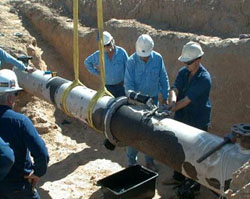Cold Cutting
Cold cutting and beveling
The first phase in the cold cutting/isolation/testing system from Carber Testing Services Europe is cold cutting. We have a lot of experience with cutting and beveling pipes.
Cold cutting has a lot of advantages over other cutting techniques that are used today. Because there is no ignition source created during the cutting the pipes don’t have to be made completely gasfree. This saves a lot of time and money because the pipes don’t need to be emptied. Another advantage is that often there is no need for a (red) hot work permit. Obviously this saves a lot of paperwork and costs. After cutting with the cold cutting tool we can also isolate the pipes with our sealing tool.
Safety is one of our top priorities. We therefore always make sure that there are no fire or flames present when cutting and beveling. This makes it impossible for combustible gasses to ignite and explode. At Carber we work with a special cold cutting tool. We use this cutting tool to cut or bevel pipes. The cold cutting tool works from the outside of the pipe to inside. Only during the last seconds of the process is the pipe is completely penetrated. By working according to this method, the hazards are greatly reduced. The contents of the pipe, which can sometimes be dangerous, are expodes to open air only for a brief period. This method cutting is better for both air quality and the staff that has to work with hazardous substances.
Cold cutting can be applied in several cases. We don’t only use the cold cutting tool for cutting pipelines but also for the cutting of reactors, storage tanks, and other machines. Cold cutting can also be used to cut through double walls or hardened steel.
Carber T.S.E. is a specialist in cold cutting and beveling. We have much experience in cold cutting and beveling and always work under strict safety regulations.
This post is also available in: Dutch


 English
English Dutch
Dutch